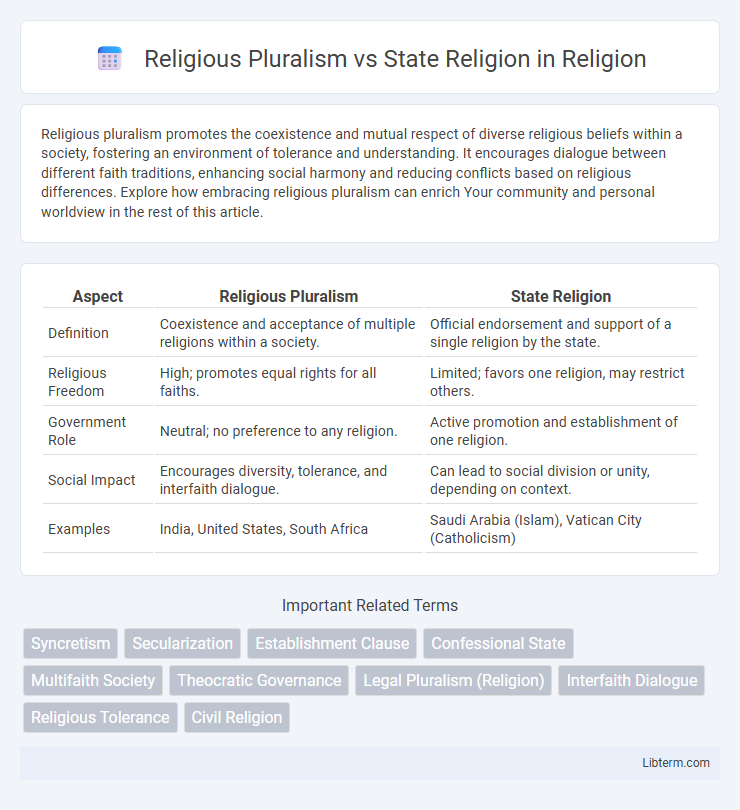Religious pluralism promotes the coexistence and mutual respect of diverse religious beliefs within a society, fostering an environment of tolerance and understanding. It encourages dialogue between different faith traditions, enhancing social harmony and reducing conflicts based on religious differences. Explore how embracing religious pluralism can enrich Your community and personal worldview in the rest of this article.
Table of Comparison
| Aspect | Religious Pluralism | State Religion |
|---|---|---|
| Definition | Coexistence and acceptance of multiple religions within a society. | Official endorsement and support of a single religion by the state. |
| Religious Freedom | High; promotes equal rights for all faiths. | Limited; favors one religion, may restrict others. |
| Government Role | Neutral; no preference to any religion. | Active promotion and establishment of one religion. |
| Social Impact | Encourages diversity, tolerance, and interfaith dialogue. | Can lead to social division or unity, depending on context. |
| Examples | India, United States, South Africa | Saudi Arabia (Islam), Vatican City (Catholicism) |
Defining Religious Pluralism and State Religion
Religious pluralism refers to a social framework that recognizes, accepts, and promotes the coexistence of multiple religious beliefs and practices within a society, emphasizing mutual respect and equal rights among diverse faith communities. State religion, also known as an established religion, is a specific religious organization officially endorsed, supported, or recognized by the government as the primary religion of the state, often influencing laws, policies, and cultural norms. The distinction lies in pluralism fostering religious diversity and freedom, while a state religion typically privileges one faith, potentially limiting equal religious expression.
Historical Context of Religious State Policies
Historical state policies on religion varied widely, with many ancient and medieval societies enforcing a single state religion to unify governance and legitimize authority, such as the establishment of Christianity in the Roman Empire under Emperor Constantine. Religious pluralism emerged in diverse empires like the Ottoman Empire, where the millet system allowed multiple religious communities to coexist under state oversight. In modern history, the transition from state-sponsored religions to secular governance models, exemplified by the French laicite and the U.S. First Amendment, reflects evolving attitudes towards religious freedom and pluralism.
Key Arguments for Religious Pluralism
Religious pluralism advocates for the coexistence and equal respect of multiple faiths within a society, emphasizing freedom of belief as a fundamental human right. It argues that state endorsement of a single religion can lead to discrimination, social division, and the suppression of minority religions. Promoting religious pluralism fosters social harmony, tolerance, and democratic values by ensuring that no religious group holds dominance over others in political and cultural spheres.
Arguments Supporting State Religion
State religion advocates argue that an official religion fosters national unity and social cohesion by providing a shared moral framework and cultural identity. It can enhance political stability by aligning governance with predominant religious values, reducing conflicts arising from divergent belief systems. Furthermore, a state religion often enables the government to regulate religious institutions, ensuring consistency and mitigating extremist influences.
Impact on Social Cohesion and Diversity
Religious pluralism fosters social cohesion by promoting mutual respect and understanding among diverse faith communities, enhancing collective identity and reducing sectarian conflicts. Conversely, a state religion often privileges a single faith tradition, which can marginalize minority groups and undermine social diversity by fostering exclusion and social fragmentation. Empirical studies indicate that societies embracing religious pluralism tend to exhibit higher levels of tolerance, inclusivity, and peaceful coexistence, contributing positively to social stability and cultural richness.
Legal Frameworks: Secularism vs Religious Establishment
Legal frameworks governing religious pluralism and state religion vary significantly, with secularism promoting a strict separation between religion and government to ensure equal treatment of all faiths. Religious establishment frameworks enshrine a particular religion as the official state faith, often influencing laws, education, and public policy. Countries like the United States emphasize secularism through the First Amendment, while the United Kingdom maintains an established church, illustrating contrasting approaches to managing religion's role in governance.
Case Studies: Countries with State Religions
Countries with state religions, such as Saudi Arabia with Islam, England with Anglican Christianity, and Thailand with Buddhism, exemplify diverse approaches to religious pluralism within governmental frameworks. These case studies reveal how state endorsement of a specific religion impacts minority religious freedoms, legal systems, and social cohesion, often balancing official religious identity with constitutional protections for other faiths. Comparative analysis highlights varying degrees of religious tolerance and integration, influencing policies on education, religious expression, and interfaith dialogue in these nations.
Case Studies: Nations Embracing Pluralism
Nations embracing religious pluralism, such as India and South Africa, demonstrate frameworks allowing multiple faiths to coexist legally and socially without endorsing a single state religion, fostering inclusive governance and protecting minority rights. India's secular constitution mandates equal treatment of all religions, promoting diverse religious expressions despite complex interfaith dynamics. South Africa's post-apartheid legal system similarly guarantees freedom of religion, supporting multiculturalism and preventing religious dominance in public policy.
Challenges and Controversies in Balancing Beliefs
Balancing religious pluralism with a state religion presents challenges such as ensuring equal rights for minority faiths while maintaining national identity tied to the official religion. Controversies often arise over legal frameworks, religious freedom, and public policy, where state endorsement of one faith may marginalize others or lead to discrimination. Managing these tensions requires nuanced governance to uphold both constitutional secularism and respect for majority religious traditions.
Future Prospects for Religion and Governance
Religious pluralism fosters inclusive governance by promoting equal representation and respecting diverse faiths within the policymaking process, which can enhance social cohesion and political stability. State religions often face challenges balancing doctrinal authority with democratic principles, potentially limiting religious freedoms and marginalizing minority groups. Future governance models are likely to emphasize adaptive frameworks that integrate pluralistic values, ensuring both religious diversity and the rule of law coexist harmoniously in increasingly multicultural societies.
Religious Pluralism Infographic

 libterm.com
libterm.com